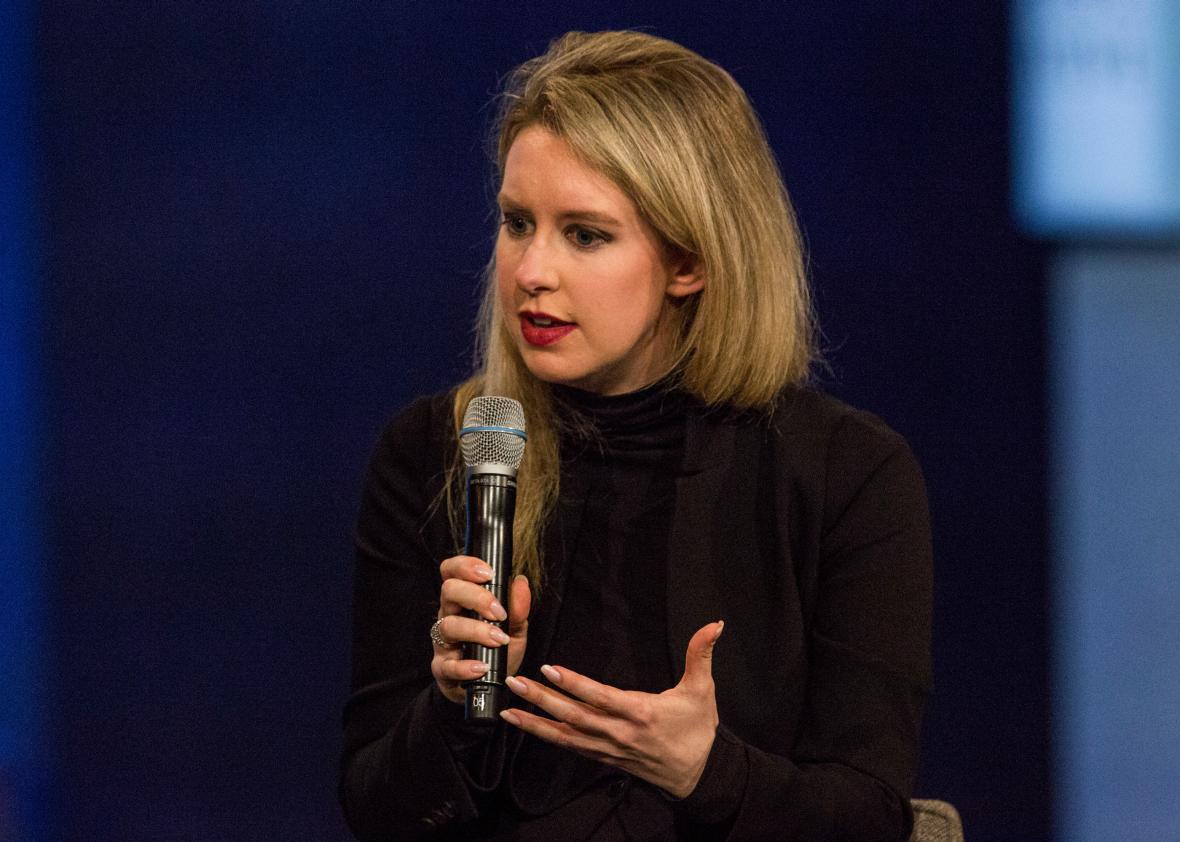As a Silicon Valley powerhouse, blood-testing startup Theranos appears to be finished. Its supposedly revolutionary technology was discredited months ago thanks to the reporting of the Wall Street Journal’s John Carreyrou; on Thursday, the company revealed that federal regulators stripped its California laboratory of its certification. Its wunderkind founder and CEO, Elizabeth Holmes, has been barred from operating any blood-testing laboratory for two years. That prohibition may also extend to the company as a whole, the Journal reports.
Theranos had at one point attained a $9 billion valuation on the strength of an apparent scientific breakthrough—whose details were kept secret even from the company’s investors—by which Theranos claimed it could detect medical conditions from just a pinprick of blood. (It turned out the company stopped using those testing machines entirely last summer and voided all their results.) In the media, Theranos was cast as a quintessential Silicon Valley success story.
If there is a way forward for the much-diminished Theranos now, though, it won’t be in California but in Arizona. By way of Theranos’ partnership with Walgreens, Arizona customers provided the bulk of the startup’s business. Phoenix was the company’s biggest market, and Theranos’ Scottsdale lab performed 90 percent of the company’s bloodwork.
In a statement released on Thursday night, the company said it would stop patient testing at its Newark, California, lab until further notice but would continue to provide service for customers at its Arizona facility.
Theranos has pressed on in Arizona despite bad news. Walgreens closed its Theranos facilities in June, not long after Arizona State University Health Services shut down its Theranos centers in downtown Phoenix and Scottsdale. A $350 million deal between Theranos and Safeway collapsed in November. It was largely Arizona customers who learned in May that they may have received faulty blood reports from the company. But Theranos pushed ahead in the state, launching an effort to open a half-dozen independent testing centers this year. An independent network of Theranos centers in Arizona was always the goal, the company said.
In one very important respect, Arizona was a better fit for Theranos than California. The company’s biggest achievements were in sales, marketing, and deregulation—rather than in medical technology. In the spring of 2015, Arizona Gov. Doug Ducey traveled to the Theranos lab in Scottsdale to sign a law, co-authored by the company, allowing Arizonans to request any blood test without a doctor’s note. In this, Holmes liked to say that Arizona was a model for the rest of the nation.
This system—known as direct-access testing—is older than Theranos, and legal in a number of other states. But the direct link to consumers was key to the Theranos business model, in which the company countered troubling regulatory reports with a big advertising budget, including banner ads at the Phoenix airport and TV and radio spots, to say nothing of the fawning press coverage.
Proponents of direct-access testing say it makes it easier for Americans to track their own medical conditions, and can save time and money. Opponents argue that blood tests should be interpreted by medically trained professionals, and that self-diagnosis can produce unwarranted paranoia and confusion. “It is essential that patients who chose to engage in direct access testing … have their test results reviewed by their primary care physician,” the American Society of Clinical Pathologists, which represents disease specialists and laboratory technicians, wrote in a policy statement.
Transforming blood tests into an over-the-counter consumer product could lead to a lot more blood tests, though. According to a January report from Kalorama Information, which does market research in medicine, direct-to-consumer lab testing has grown from a $15 million business in 2010 to $130 million in 2015, and is expected to nearly triple by 2020.
Theranos may have pushed hardest for the change in Arizona, but it paved the way for competitors.
Sonora Quest, Arizona’s biggest clinical testing service, opposed the Arizona direct-access testing bill when it was proposed in the statehouse. “We continue to maintain that the management of personal health is most effective when it involves a partnership with a primary care provider,” the company said in a statement in April 2015.
Two months later, though, the company was ready to take advantage of the new environment. “This is a new era in health care consumerism,” David Dexter, the president and CEO of Sonora Quest, said in July. The company debuted a program called “My Lab ReQuest,” that allowed Arizonans to order lab tests without a doctor’s involvement.
After the collapse of Theranos’ reported megadeal with Safeway last fall, which would have put clinics in 800 supermarkets, the supermarket giant struck an agreement with Sonora Quest to install clinics in a handful of Arizona stores.
Even if it now employs run-of-the-mill needle technology, though, Theranos offers a much larger menu of tests, and at much lower prices, than the competition. Sujeet Indap, writing in the Financial Times, observed that the company’s brochure had the bewildering scope of a Chinese restaurant menu—and that many results (gleaned from five full vials of blood) were inscrutable without a doctor’s assistance. Such a test would not have been possible in California, which has limits on what types of direct-access testing are allowed.
That no-regulation approach to blood-testing, one driven by consumers and testing companies rather than doctors—more than Theranos’ mythical Edison machine—that is the company’s legacy. And if Theranos survives, it will be on the strength of that model, which is more of an Arizona-style innovation than a California one.
But whether a boom in self-ordered blood-testing is a good thing for American health care is another question entirely.
